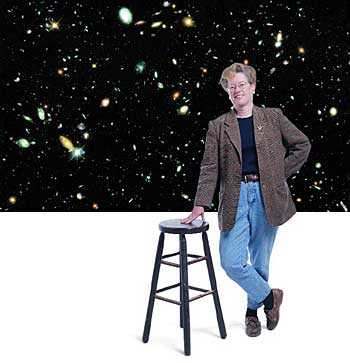|
deep space, Frontiers of SpaceAstronomer Sandra Faber stands before the Hubble Deep Field, an image taken in 1995 that focused on atiny, random patch of sky and revealed the most distant galaxies ever seen. The faintest objects show us galaxies as they were long ago--some 12 billion years back in time.(Photos: R. R. Jones; R. Williams
and
The heart of the project is a survey of around 50,000 faint galaxies. Light from these remote galaxies has taken billions of years to reach earth, enabling astronomers to study the universe when it was about half its current age, long before earth and the rest of the solar system came into being. "We will be able to compare distant galaxies with local galaxies to understand how they formed and evolved over time," says Sandra Faber, University Professor of Astronomy and Astrophysics. The project, called the Deep Extragalactic Evolutionary Probe, or DEEP, was conceived almost ten years ago by Faber and two of her colleagues, professors of astronomy and astrophysics David Koo and Garth Illingworth. Collaborators include other researchers at UCSC and experts at several other universities, including UC Berkeley, the California Institute of Technology, and the University of Hawaii. The DEEP project's findings will help answer fundamental questions about the origins of the universe and its ultimate destiny. "We're interested in not only the properties of the individual galaxies, but also how they relate to one another, whether they are grouped into little villages of galaxies or big cities," Koo says. "From the way galaxies are distributed and their motions we can get clues to the geometry of the universe, whether the expansion of the universe is accelerating, and how it will change over time." The bulk of the DEEP project's observations will be obtained with the ultra-efficient DEIMOS spectrograph, currently under construction at UCSC under Faber's direction and scheduled to begin operation on the Keck II Telescope late this year. A spectrograph separates the light from a distant object into a spectrum of different wavelengths, much like a prism breaks up sunlight into a rainbow of colors. From the spectrum, astronomers can determine critical information about a galaxy, including its distance and internal dynamics. DEIMOS will be able to gather spectra seven times faster than the Keck Observatory's current instruments, which the researchers have used to survey about 1,000 galaxies so far.
Just as important as the spectra obtained at Keck are images of the distant galaxies captured by the Hubble Space Telescope. "In the study of distant galaxies, the Hubble and Keck Telescopes complement each other, like yin and yang," Faber says. "The Hubble has unparalleled resolution because it orbits above earth's atmosphere, so it gives us beautiful images that show what the galaxies look like--their shape and size," she explains. But the Hubble is not an especially large telescope, so it does not collect enough light from these distant galaxies for spectroscopic studies. The twin Keck Telescopes, which are the largest optical telescopes in the world, have the light-gathering capacity needed for detailed spectroscopic analysis of light from distant, faint galaxies. Astronomers determine the distance to a galaxy from its "redshift," a measure of how much the light from a distant object has been shifted to longer ("redder") wavelengths by the expansion of the universe. From the combination of Hubble images and Keck spectra, the researchers can also determine a galaxy's brightness, its radius (how big it is), and its internal velocity or rotation speed. "Those three parameters are the Holy Grail--they can tell you all you need to know about a galaxy," Faber says. According to Koo, the ability to derive the masses of distant galaxies from these parameters distinguishes the DEEP project from other galaxy surveys. "The mass measurements provide a very important link to theoretical models of galaxy formation and evolution," he says. The bulk of the DEEP survey is concerned with a population of galaxies with redshifts around 1, representing the universe when it was about half its current age, or about 67 billion years ago. On a smaller scale, Faber and her colleagues have extended their observations even further to include some of the most distant galaxies known, at redshifts of 2.5 and beyond. These galaxies represent the universe more than 10 billion years ago, at about 10 to 15 percent of its current age. "The morphology of these very distant galaxies is peculiar--they look like blobs, not like the nice spirals and elliptical galaxies we see nearby," Faber says. "At a redshift of 1, however, the galaxies are looking much more normal. So a major question we hope to answer is, how did this transition happen?" --Tim Stephens
|
 A
team of astronomers at UC Santa Cruz has embarked on a journey back
in time to map the universe as it was billions of years ago. Using the
unique capabilities of the Hubble Space Telescope and the W. M. Keck
Observatory in Hawaii, the researchers have begun the most comprehensive
survey of distant galaxies ever attempted.
A
team of astronomers at UC Santa Cruz has embarked on a journey back
in time to map the universe as it was billions of years ago. Using the
unique capabilities of the Hubble Space Telescope and the W. M. Keck
Observatory in Hawaii, the researchers have begun the most comprehensive
survey of distant galaxies ever attempted.